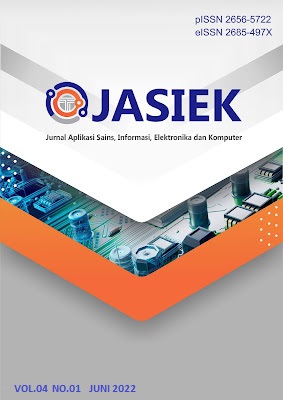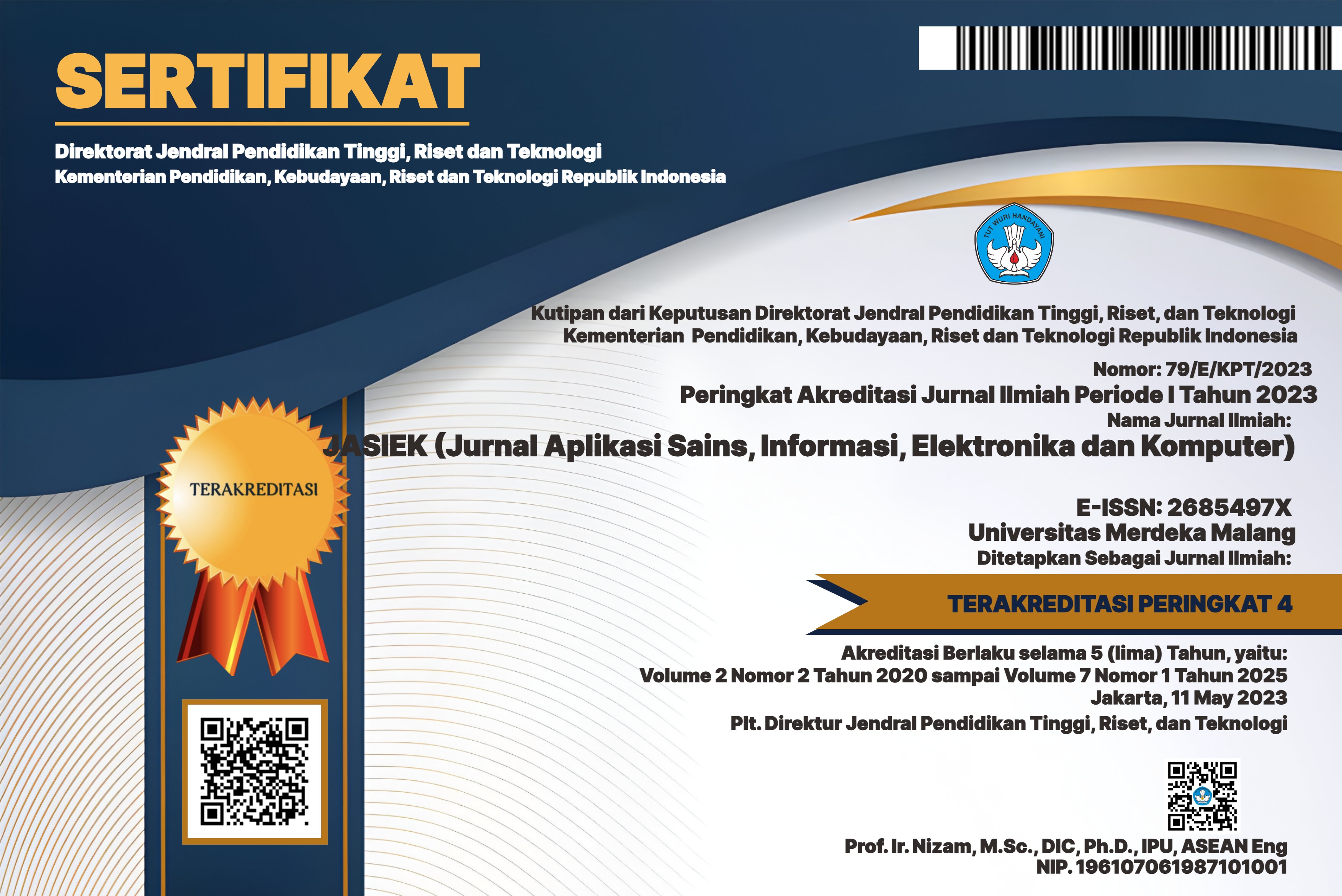Purwarupa Robot Pipe Following Pendeteksi Kebocoran Gas Internet of Things Berbasis Web dan Aplikasi Android
DOI:
https://doi.org/10.26905/jasiek.v4i1.8465Keywords:
Android, Gas Leak, Internet of things, Pipe Following, RoboticAbstract
Indonesia is one of the largest producers/producers and consumers of natural gas in the world. The large demand for gas makes the gas industry continue to produce. Gas pipes used in industry have very large sizes. This makes it difficult for workers to carry out pipe maintenance. In the gas production process, there is the possibility of gas leaks that threaten the safety of the workers. Therefore, this research is expected to help workers. A mobile pipe following robot that can detect gas leaks. Robot control can be done manually and automatically. The robot is also based on the internet of things that can be controlled via an android application and the gas leak data will be stored in a web database.Downloads
References
R. Arindya, Efektivitas organisasi tata kelola minyak dan gas bumi. Media Sahabat Cendekia, 2019.
“Gas Alam | Indonesia Investments.†https://www.indonesia-investments.com/id/bisnis/komoditas/gas-alam/item184? (accessed Aug. 30, 2022).
D. S. Priyarsono, M. Tambunan, and M. Firdaus, “Perkembangan konsumsi dan penyediaan energi dalam perekonomian Indonesia,†IJAE (Jurnal Ilmu Ekonomi Pertanian Indonesia), vol. 1, no. 02, 2012.
I. Kurniaty and H. Hermansyah, “Potensi Pemanfaatan Lpg (Liquefied Petroleum Gas) sebagai Bahan Bakar Bagi Pengguna Kendaraan Bermotor,†Prosiding Semnastek, 2016.
Y. Ilmansyah, N. A. Mahbubah, and D. Widyaningrum, “Penerapan Job Safety Analysis sebagai Upaya Pencegahan Kecelakaan Kerja dan Perbaikan Keselamatan Kerja di PT Shell Indonesia,†PROFISIENSI: Jurnal Program Studi Teknik Industri, vol. 8, no. 1, pp. 15–22, 2020.
A. Pinandito, “Penentuan Ukuran Pipa Berdasarkan Laju Alir Maksimum Terjadi Erosi Dengan Persamaan Erosional Flow Pada Pipa Salur Sumur X Lapangan Y,†2021.
E. Nebath, D. Pang, and J. O. Wuwung, “Rancang Bangun Alat Pengukur Gas Berbahaya CO Dan CO2 di Lingkungan Industri,†Jurnal Teknik Elektro dan Komputer, vol. 3, no. 4, pp. 65–72, Oct. 2014, doi: 10.35793/JTEK.3.4.2014.6012.
S. Utomo, “Bahan berbahaya dan beracun (B-3) dan keberadaannya di dalam limbah,†Jurnal Konversi, vol. 1, no. 1, 2012.
R. Braunstingl, J. Mujika, and J. P. Uribe, “Wall following robot with a fuzzy logic controller optimized by a genetic algorithm,†IEEE International Conference on Fuzzy Systems, vol. 5, pp. 77–82, 1995, doi: 10.1109/FUZZY.1995.410047.
S. K. Risandriya and F. R. Pakpahan, “Robot Patroli Gas LPG pada Pipa Berbasis Logika Fuzzy,†Jurnal Integrasi, vol. 6, no. 2, pp. 134–139, 2014.
M. Ciszewski, M. Wacławski, T. Buratowski, M. Giergiel, and K. Kurc, “Design, modelling and laboratory testing of a pipe inspection robot,†Archive of Mechanical Engineering, pp. 395–407, 2015.
Downloads
Published
Issue
Section
License
Authors who publish with this journal agree to the following terms:
The journal allow the authors to hold the copyright without restrictions and allow the authors to retain publishing rights without restrictions.
Authors retain copyright and grant the journal right of first publication with the work simultaneously licensed under a Creative Commons Attribution-ShareAlike 4.0 International License that allows others to share the work with an acknowledgement of the work's authorship and initial publication in this journal.
Authors are able to enter into separate, additional contractual arrangements for the non-exclusive distribution of the journal's published version of the work (e.g., post it to an institutional repository or publish it in a book), with an acknowledgement of its initial publication in this journal.
Authors are permitted and encouraged to post their work online (e.g., in institutional repositories or on their website) prior to and during the submission process, as it can lead to productive exchanges, as well as earlier and greater citation of published work (See The Effect of Open Access).

This work is licensed under a Creative Commons Attribution-ShareAlike 4.0 International License.











